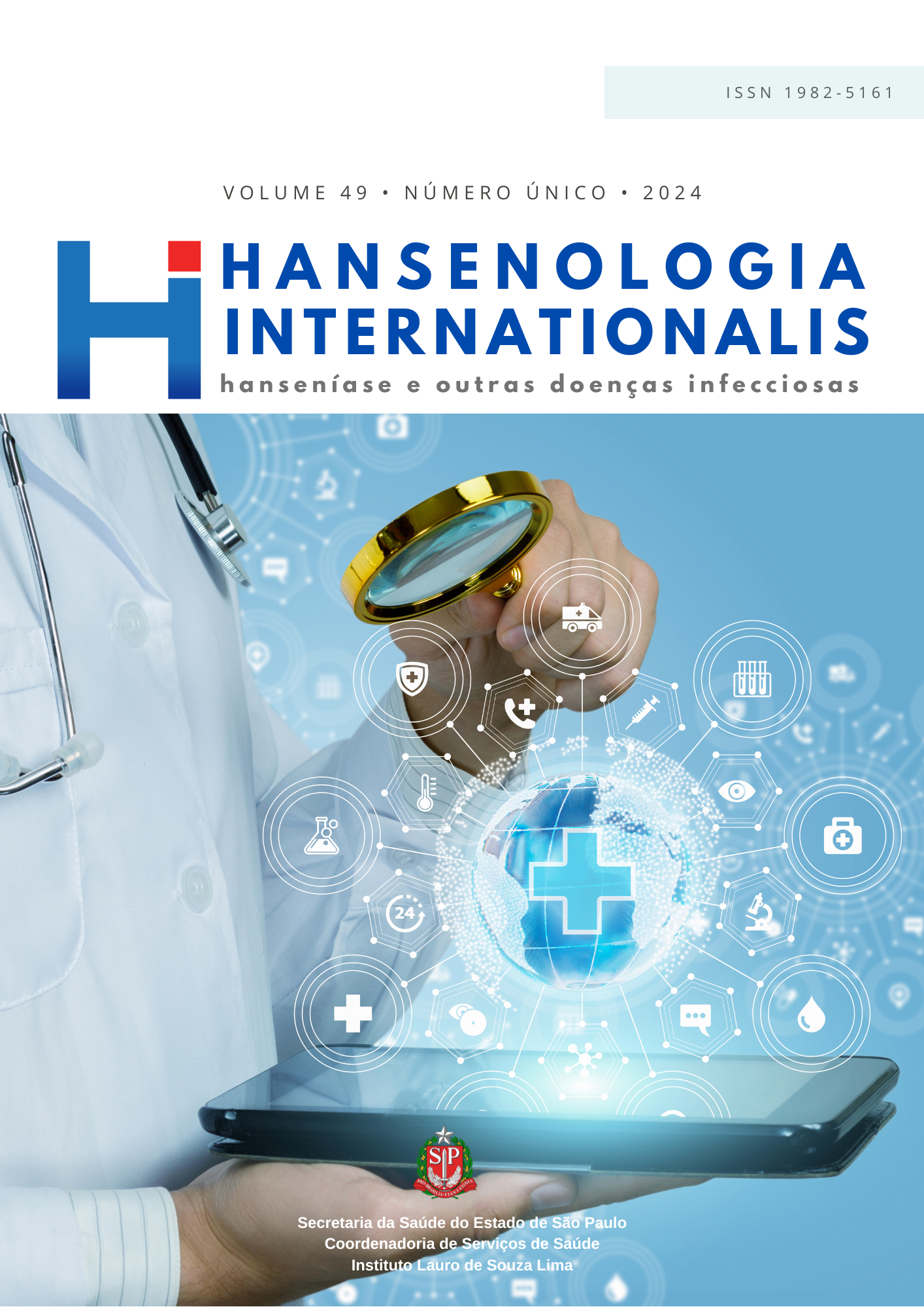Abstract
Introduction: leprosy reactions have the potential to cause disabilities. Many individuals experience recurrent episodes of reaction during treatment. Objective: to identify clinical and histopathological characteristics that differentiate patients with leprosy reactions from those without leprosy reactions. Method: this is a prospective study conducted from July 2015 to December 2016, evaluating individuals newly diagnosed with leprosy and treated at the dermatology service of the Clementino Fraga Hospital Complex in João Pessoa, Paraíba, Brazil. The subjects were classified according to the Ridley-Jopling/Madrid criteria and operational classification. They underwent a histopathological examination at the time of diagnosis and 12 months later, and were reassessed 6 and 12 months after the diagnosis. Results: the group without a reaction had a greater number of lesions with clear delimitation. Individuals with a reaction showed a predominance of multibacillary forms. The group with a reaction had a greater number of individuals with a degree of disability greater than zero. A positive correlation was observed between the bacilloscopic index and the occurrence of reactions. Discussion: the lack of clear boundaries around the lesions may be linked to the onset of a leprosy reaction. The higher incidence of reactions in individuals with some degree of physical disability indicates a correlation between disability and multibacillary disease. Additionally, a positive correlation was found between the bacilloscopic index of the biopsy and the occurrence of reactions. Conclusion: the high incidence of severe reactions underscores the need for ongoing studies on leprosy and the identification of early clinical characteristics that suggest leprosy reactions.
References
1. Lastória JC, Abreu MAMM. Hanseníase: revisão dos aspectos laboratoriais e terapêuticos - parte 2. An Bras Dermatol. 2014 Jun 1;89(3):389-401.
2. Ambrosano L, Santos MAS, Machado ECFA, Pegas ES. Epidemiological profile of leprosy reactions in a referral center in Campinas (SP), Brazil, 2010-2015. An Bras Dermatol. 2018 Jun;93(3):460-1.
3. Penna GO, Pinheiro AM, Nogueira LS, Carvalho LR, Oliveira MB, Carreiro VP. Clinical and epidemiological study of leprosy cases in the University Hospital of Brasília: 20 years – 1985 to 2005. Rev Soc Bras Med Trop. 2008;41(6):575-80.
4. Maymoma MB, Venkatesh S, Laughter M, Stryjewska BM, Dunnick CA, Dellavalle RP. Leprosy: treatment and management of complications. J Am Acad Dermatol. 2020;83(1):17-30.
5. Khadge S, Banu S, Bobosha K, Ploeg-van Shipp JJ, Goulart IM, Thapa P, et al. Longitudinal immune profiles in type 1 leprosy reactions in Bangladesh, Brazil, Ethiopia and Nepal. BMC Infect Dis. 2015 Oct 28;15(1).
6. Froes Junior LAR, Sotto MN, Trindade MAB. Hanseníase: características clínicas e imunopatológicas. An Bras Dermatol. 2022 May 1;97(3):338-47.
7. Dupnik KM, Bair TB, Maia AO, Amorim FM, Costa MR, Keesen TSL, et al. Transcriptional changes that characterize the immune reactions of leprosy. J Infect Dis. 2014 Nov 14;211(10):1658-76.
8. Feuth M, Brandsma JW, Faber WR, Bhattarai B, Feuth T, Anderson AM. Erythema nodosum leprosum in Nepal: a retrospective study of clinical features and response to treatment with prednisolone or thalidomide. Lepr Rev. 2008 Sep 1;79(3):254-69.
9. Motta AC, Furini RB, Simão JC, Ferreira MA, Komesu MC, Foss NT. The recurrence of leprosy reactional episodes could be associated with oral chronic infections and expression of serum IL-1, TNF-alpha, IL-6, IFNgama and IL-10. Braz Dent J. 2010;21(2):158-64.
10. Motta AC, Pereira KJ, Tarquinio DC, Vieira MB, Miyake K, Foss NT. Leprosy reactions: coinfections as a possible risk factor. Clinics. 2012;67(10):1145-48.
11. Talhari SG, Penna GO, Gonçalves HS, Oliveira ML. Hanseníase. 5. ed. Manaus: Di Livros Editora; 2015.
12. Nery JA, Bernardes Filho F, Quintanilha J, Machado AM, Oliveira SS, Sales AM. Understanding the type 1 reactional state for early diagnosis and treatment: a way to avoid disability in leprosy. An Bras Dermatol. 2013;88(5):787-92.
13. Mungroo MR, Khan NA, Siddiqui R. Mycobacterium leprae: pathogenesis, diagnosis, and treatment options. Microb Pathog. 2020 Sep;149:104475.
14. Putinatti MS, Lastoria JC, Padovani CR. Prevention of repeated episodes of type 2 reaction of leprosy with the use of thalidomide 100 mg/day. An Bras Dermatol. 2014;89(2):266-72.
15. Santos ALS, Pereira IV, Ferreira AMR, Palmeira IP. Percepções de portadores de hanseníase sobre as reações hansênicas e o cuidado de si. Rev Pan-Amaz Saúde. 2018 May;9(4):37-46.
16. Rodrigues R, Heise E, Hartmann LF, Rocha G, Olandoski M, Stefani M, et al. Prediction of the occurrence of leprosy reactions based on Bayesian networks. Front Med. 2023;10:1233220.
17. Luo Y, Kiriya M, Tanigawa K, Kawashima A, Nakamura Y, Ishii N, et al. Host-related laboratory parameters for leprosy reactions. Front Med. 8:694376.
18. Teixeira MAG, Silveira VM, França ER. Características epidemiológicas e clínicas das reações hansênicas em indivíduos paucibacilares e multibacilares, atendidos em dois centros de referência para hanseníase, na Cidade de Recife, Estado de Pernambuco. Rev Soc Bras Med Trop. 2010 Jun;43(3):287-92.
19. Putri AI, de Sabbata K, Agusni RI, Alinda MD, Darlong J, de Barros B, et al. Understanding leprosy reactions and the impact on the lives of people affected: an exploration in two leprosy endemic countries. PLOS Negl Trop Dis. 2022 Jun 13;16(6):e0010476.
20. Queiroz TA, Carvalho FPB, Simpson CA, Fernandes ACL, Figueirêdo DLA, Knackfuss MI. Perfil clínico e epidemiológico de pacientes em reação hansênica. Rev Gaúcha Enferm. 2015;36(spe):185-91.
21. Van Veen NH, Meima A, Richardus JH. The relationship between detection delay and impairment in leprosy control: a comparison of patient cohorts from Bangladesh and Ethiopia. Lepr Rev. 2006;77(4):356-65.
22. Moschioni C, Antunes C, Grossi MP, Lambertucci JR. Risk factors for physical disability at diagnosis of 19,283 new cases of leprosy. 2010 Feb 1;43(1):19-22.
23. Monteiro LD, Alencar CH, Barbosa JC, Novaes CCBS, Silva RCP, Heukelbach J. Limited activity and social participation after hospital discharge from leprosy treatment in a hyperendemic area in north Brazil. Rev Bras Epidemiol. 2014 Mar;17(1):91-104.

This work is licensed under a Creative Commons Attribution 4.0 International License.
Copyright (c) 2024 Juliana Nunes Maciel Cilento, Neusa Yuriko Sakai Valente, Gabriela de Lira Pessoa Mota, Maria Carolina Alves Monteiro de Melo, Alana Wanderley Mariano e Silva, Linácia Freitas Vidal
